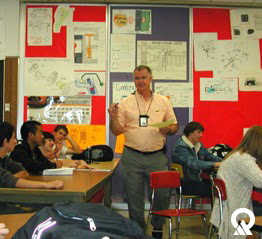By Scott Hopkins
If you like to do your own maintenance on your car and wonder about used oil disposal, you’re in luck:
Utah has one of the best used-oil collection programs in the country. Thanks to more than 400 Used Oil Collection Centers (UOCCs) conveniently located in every county in the state, do-it-your-self (DIYers), farmers and ranchers can easily dispose of their used oil in an environmentally safe manner.
Editor’s Note: This is the second of a series of posts—during the month of September—focused on simple home improvement tips to help improve your quality of life and the environment.


Improper disposal of used oil can pose significant environmental hazards. Because used oil is not water-soluble, it can take decades to biodegrade. Pouring used oil from a single oil change into a storm drain can foul a million gallons of water, contaminating waterways and drinking water sources, and harming wildlife.
There was a time when DIYers had limited disposal options. That changed in the mid-1990s, when state legislation provided financial incentives for businesses to operate collection centers through funding from the Division of Solid and Hazardous Waste (DSHW)’s Used Oil Recycling Block Grant and the used oil reimbursement program.
Used oil is a valuable commodity. It can be reformulated into fuel oil and burned in furnaces to heat homes, schools and businesses. It can also be used as bunker fuel for ships, re-refined into new oil, or used as an additive to asphalt. Some companies are paying upwards of $1.50 per gallon for used oil and demand continues to increase. Some UOCC facilities in Utah use specially designed furnaces to burn the used oil they generate and collect to heat their buildings during the cold winter months.
Generally, UOCCs can accept up to five gallons of used oil from a DIYer per visit, and many will also accept used oil from farmers and ranchers. In 2012, DIYers recycled more than 500,000 gallons at collection centers, an eight percent increase from the previous year.
Increased public awareness is largely responsible for this record growth. As part of DSHW planning and community outreach program, I travel throughout the state to talk with high school students, community groups and businesses about the value of oil recycling. Because I have been with DEQ for 38 years, I am able to share some of my many environmental experiences—good and bad—with participants to illustrate the progress we have made in environmental protection, as well as what still needs to be done to properly manage the wastes that we generate.
I like to keep my program interactive and entertaining, and I encourage group participation and questions. Using stories and pictures, I show what can be done with used oil, what it is used for, and how to properly recycle the oil we generate. In addition, our outreach program can provide volunteers, Eagle Scouts and civic organizations with informational handouts and reminder stickers to help them explain the benefits of our used oil program to others in their communities.

You can find the collection center closest to you by checking out our website, or by calling our toll-free hotline at (801) 458-0145. Just a reminder—UOCCs only accept oil during posted business hours. If you are interested in arranging an presentation for your company, school class, professional trade association, church, or social group, please contact me at (801) 536-0235 or email me (shopkins@utah.gov). I look forward to hearing from you!
I am a graduate of the University of Utah and began working for the State of Utah in 1976, where I spent my first 10 years collecting and analyzing water samples. In 1986, I moved to the Division of Solid and Hazardous Waste, where I wrote and enforced permits for companies that generated and disposed toxic and hazardous wastes. Since 2010, I have overseen the used oil program. I love to travel with my wife, Mona, and the rest of my family—particularly my six grand-kids. I have been all over the world, most recently for a 12-day visit to Israel.

